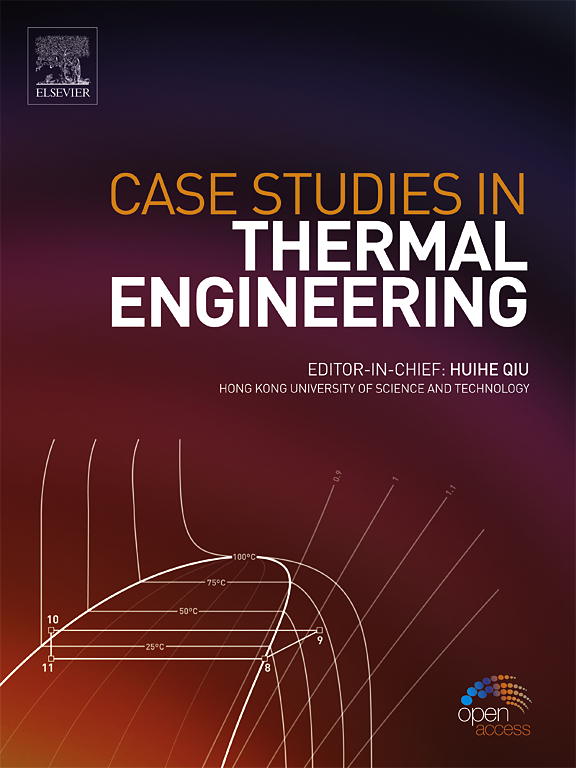ZnO/Al2O3混合纳米流体改善光伏板冷却性能的数值-实验研究
IF 6.4
2区 工程技术
Q1 THERMODYNAMICS
引用次数: 0
摘要
混合纳米流体,特别是ZnO和Al2O3纳米颗粒,在提高光伏板的冷却性能方面显示出巨大的潜力。这解决了过热问题,这是光伏系统的一个主要问题,它会导致效率损失。本研究使用0.02%的混合纳米流体(Al2O3/Zno)流动在光伏板的底部进行冷却。在这项工作中,提出了改善光伏冷却的建议,并对比了风冷、水冷和混合纳米流体冷却面板的热电效率。本文结合了三种冷却技术的全面案例研究,并使用混合数值-实验方法进行CFD模拟,为光伏在现实世界中的应用提供了实用的见解。采用CFD模型对三块具有相同规格的光伏板进行了测试,分别在单道系统中通过水、空气和混合纳米流体进行冷却。实验和数值比较了混合纳米流体冷却电池和水冷风冷电池的性能。与水和空气相比,混合纳米流体的电效率值在数值和实验上都有所提高。2023年6月。在实验和数值上,与空气和水相比,混合纳米流体的功率有所提高。混合纳米流体冷却的PV温度分别比风冷和水冷降低。混合纳米流体,特别是ZnO和Al2O3在提高光伏板的冷却性能方面显示出有希望的结果,从而提高太阳能系统的效率和整体有效性。本文章由计算机程序翻译,如有差异,请以英文原文为准。
Numerical-experimental study to improve photovoltaic panel cooling by using hybrid ZnO/Al2O3 nanofluids
Hybrid nanofluids, specifically ZnO and Al2O3 nanoparticles, have shown significant potential in enhancing the cooling performance of photovoltaic panels. This tackles overheating, a major issue with PV systems, which results in efficiency losses. This study used 0.02 % hybrid nanofluid (Al2O3/Zno) flowing at the bottom of PV panels for cooling. In this work offers suggestions for improving PV cooling and contrasts the thermal and electrical efficiency of air-cooled, water-cooled, and hybrid nanofluid-cooled panels. The paper combines a thorough case study of three cooling techniques with CFD simulations using a mixed numerical-experimental methodology, providing practical insights for PV applications in the real world. Three PV panels with the same specifications that were cooled by water, air, and a hybrid nanofluid in a single-pass system were examined using CFD models. Results were compared between hybrid nanofluid-cooled cells and water-air-cooled cells experimentally and numerically. The electrical efficiency values of hybrid nanofluids have increased compared to water and air numerically and experimentally. Along June 2023. The power increases when using hybrid nanofluids compared to air and water respectively experimentally and numerically. The PV temperature of hybrid nanofluids cooling is decreasing compared to air-cooled and water-cooled respectively. Hybrid nanofluids, especially ZnO and Al2O3 have shown promising results in enhancing the cooling performance of photovoltaic panels, leading to increased efficiency and overall effectiveness of solar energy systems.
求助全文
通过发布文献求助,成功后即可免费获取论文全文。
去求助
来源期刊

Case Studies in Thermal Engineering
Chemical Engineering-Fluid Flow and Transfer Processes
CiteScore
8.60
自引率
11.80%
发文量
812
审稿时长
76 days
期刊介绍:
Case Studies in Thermal Engineering provides a forum for the rapid publication of short, structured Case Studies in Thermal Engineering and related Short Communications. It provides an essential compendium of case studies for researchers and practitioners in the field of thermal engineering and others who are interested in aspects of thermal engineering cases that could affect other engineering processes. The journal not only publishes new and novel case studies, but also provides a forum for the publication of high quality descriptions of classic thermal engineering problems. The scope of the journal includes case studies of thermal engineering problems in components, devices and systems using existing experimental and numerical techniques in the areas of mechanical, aerospace, chemical, medical, thermal management for electronics, heat exchangers, regeneration, solar thermal energy, thermal storage, building energy conservation, and power generation. Case studies of thermal problems in other areas will also be considered.
 求助内容:
求助内容: 应助结果提醒方式:
应助结果提醒方式:


